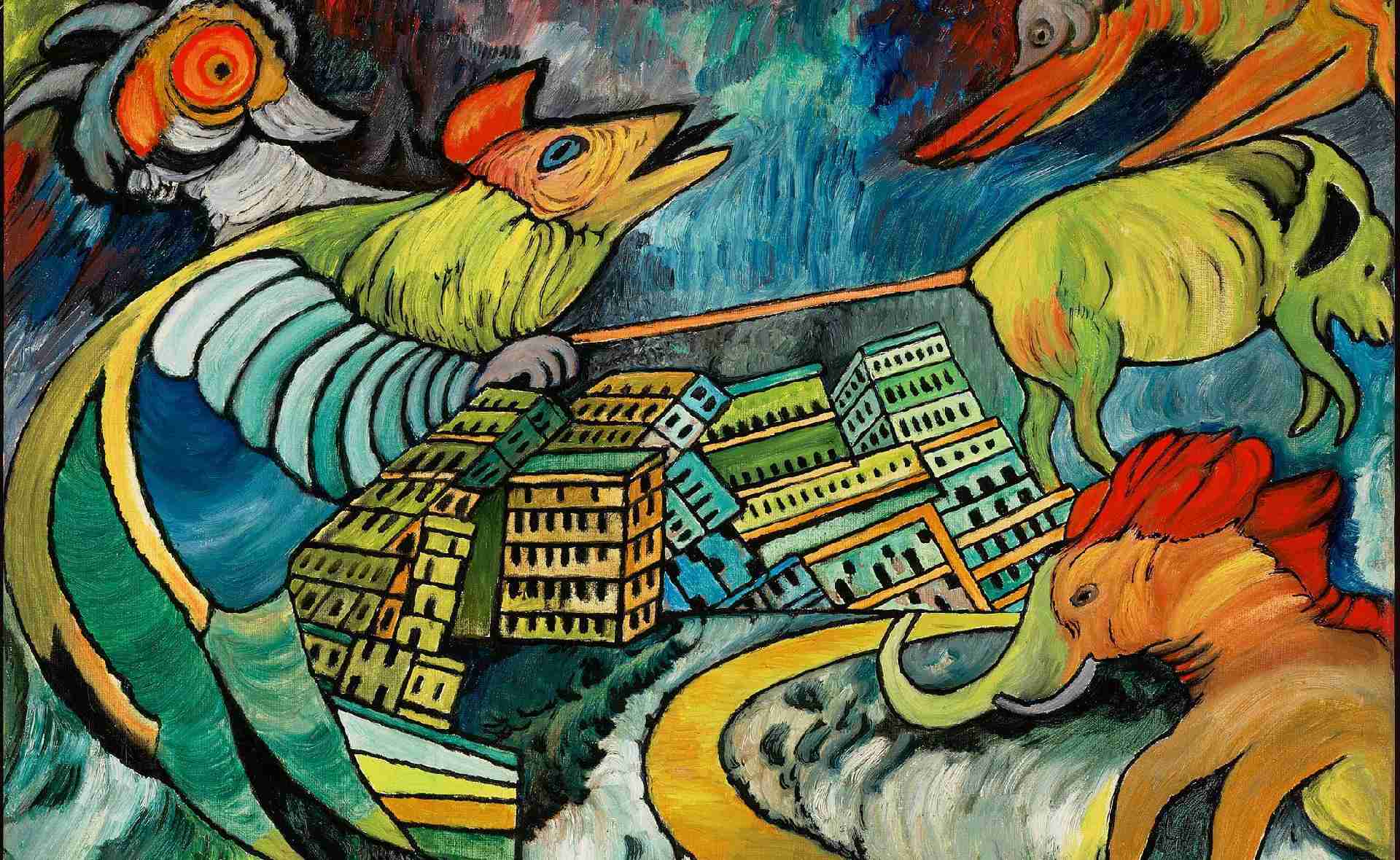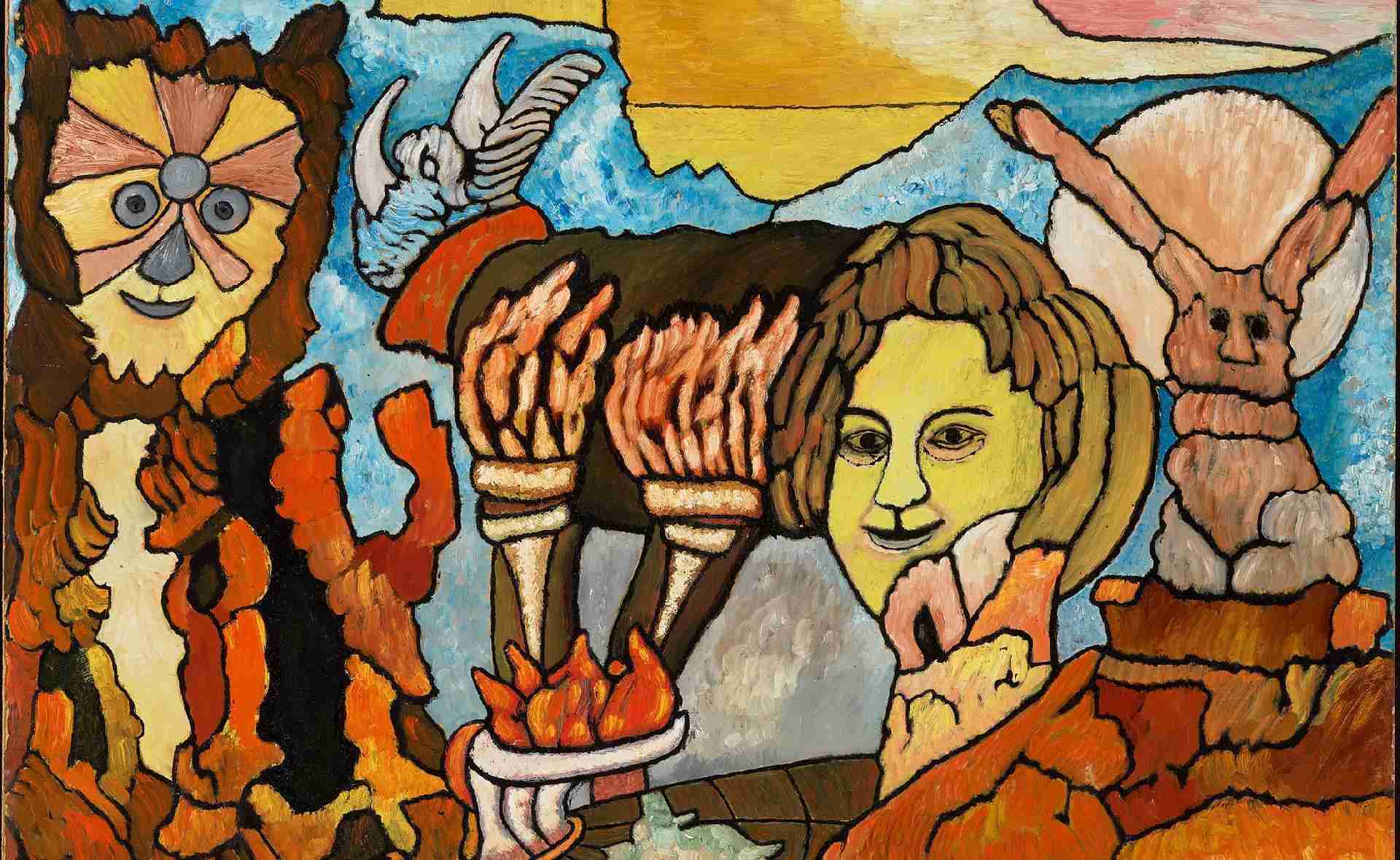10 Treurenberrg, 1000 Brussels

János Balázs, Roma painter and poet (27 November 1905, Alsókubin - 18 March 1977, Salgótarján) He started drawing as a child, then stopped for decades, and only started working again in 1968, at the age of 63. In his magical works, his inner visions are combined with the mystical world of roma tales and elements of reality. Monumentality, a surreal combination of motifs that completely fill the picture surface, and a heightened colour world characterise his painting.
Both his grandfather and father were well-known violonists. At the age of five, he was left half-orphaned and moved with his family to the roma settlement of Pécskődomb in the centre of Salgótarján.
János Balázs was only able to start his schooling. In truth, he did not like the confinement of the desks and walls, the strictness of the teachers. He didn't even start the third grade. But he learned to read and became an 'omnivore'. The letter became his god, and he accumulated an incredible amount of knowledge and experience, which decades later he would present in his own words. A grumpy, restless lad, he lived his life like a handyman: repairing instruments, cleaning chimneys, doing 'everything'. He became a thinking, argumentative young man.
As a soldier he served in the 23rd Infantry Regiment in Losonc. He was 37 when he was taken to the front. He was taken prisoner of war in 1944, and although the war ended soon after, he was to serve three more years in the Soviet Union, in the Saratov prison camp. There he read widely, mainly Hungarian classics, as well as Shakespeare, Homer and Balzac. He returned home from prisoner of war at the age of 43. He never left Salgótarján again.

He let no one come close to him, and began to write poetry and paint as a sullen hermit. The forest is his life, he collects mushrooms, picks dead twigs and feeds on forest fruits. He makes charcoal from the heaps, sows clay and makes musical instruments. His hut is visited by children alone, who, seeing his drawings, persuade him to paint and bring him the ingredients: rags, scraps of planks and paint scraps. Painting and writing are his only pleasure and entertainment. The children admire the strange old man, but the environment does not understand.
The history, the fate of the Hungarian and Gypsy people, their myths, his incredible lexical knowledge, appear as a fantastic avalanche of poems and take shape in pictorial visions. Everything interests him. History, the fate of humanity, the gypsy colony, flowers and animals, Hiroshima - visions and reality. As a hermit, János Balázs matures into a Renaissance man. He wants to touch everything, to add something to everything. He creates without leaving his familiar environment, without electricity, radio, newspapers or television. His information is mixed with the original, ancient ideas in his genes, and perhaps this is the reason for his exuberant colourfulness. The images are 'a confused mystery', as he himself puts it, 'the whole existence of the world is hidden in them'.
Never able to part with his paintings, he once decided to sell thirteen of them in order to publish his book Smokes.
Although he was discovered by the media, he couldn't deal with the fame. Corvina Publishers publishes "With Brush and Pen", a selection of his poems and paintings. He is the subject of a portrait film, interviewed by TV reporters and journalists.
The "artist" is moved to Salgótarján, and initiated masters begin to teach him how he should paint, now "scientifically". He cannot cope with the hype and popularity. They kill not only the artist, but also the man. He is paralysed and unable to realise that he can no longer create. He lives his last years immobile, bedridden, self-mutilated, idle.
János Balázs was and remains a unique phenomenon in Hungarian and international painting. He developed a unique, inimitable painterly language. His active creative period lasted only 8 years. His poetry and painting are not accidental. These paintings and these poems, which are important for both Hungarian and Roma culture, had to be born and to be present. He painted like an adult left as a child - that is how he could see and visualise the world, with its fantastic colours, animals, landscapes and people.
In his memory
In 2006, a statue was erected in his honour in Salgótarján (by Tamás Szabó).
The Roma Parliament Gallery (Budapest, Tavaszmező u. 6., district VIII.) bears his name.
A portrait film was made about him.
His exhibitions
2002 - Nógrád History Museum, Salgótarján
2002 - Nógrád History Museum, Salgótarján
2005 - Nógrád History Museum, Salgótarján
Selected group exhibitions
1972 - Hungarian naive art in the 20th century, Hungarian National Gallery, Budapest
1973 - International amateur exhibition, Ernst Museum, Budapest
1984 - International naive exhibition, London
Outdoor works
1971 - József Attila Cultural Centre, Salgótarján
1972 - Metallurgical Cultural Centre, Salgótarján
1973 - Járási Művernődési Ház, Derecske
1977 - Museum of Hungarian Naive Art, Kecskemét
1991 - Mini Gallery, Miskolc
Works in public collections
Museum of Hungarian Naive Art, Kecskemét
Nógrád History Museum, Salgótarján
Writings
Füstölgések (poems), author's edition, Budapest, 1973.
Brush and pen (autobiography and poems), Corvina Kiadó, Budapest, 1977, ISBN 9631301818
The exhibition is organised in collaboration with Kálmán Makláry Fine Arts and the Horn Collection.
